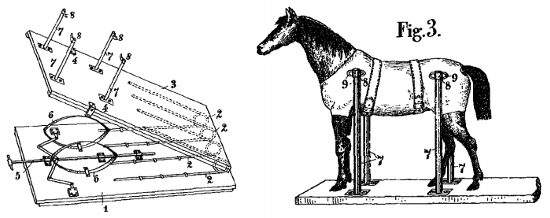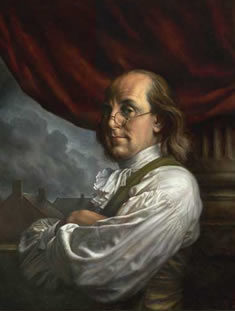“Every time an idiot dies, your IQ goes down.” — Bill Ballance
Hot and Cold
Suppose you have three identical Dewar flasks labeled A, B, and C. (A Thermos is a Dewar flask.) You also have an empty container labeled D, which has thermally perfect conducting walls and which fits inside a Dewar flask.
Pour 1 liter of 80°C water into flask A and 1 liter of 20°C water into flask B. Now, using all four containers, is it possible to use the hot water to heat the cold water so that the final temperature of the cold water is higher than the final temperature of the hot water? How? (You can’t actually mix the hot water with the cold.)
More Madan
Further excerpts from the notebooks of Geoffrey Madan:
“Curious how much more room dirty clothes take up than clean ones, when you’re packing — quite out of proportion to the amount of dirt they contain.” — Claud Russell
Sworded/sordid: an absurd homonym.
“The cost of a thing is the amount of what I call life which has to be exchanged for it, immediately or in the long run.” — F.H. Bradley
Hua [French master at Eton] and Warre could neither pronounce the other’s name, but each made the same sound in the attempt.
The fascination, to a crowd, of anything going up the side of a building on a rope or lift: exceedingly primitive.
“A hamper is undoubtedly requisite under the present circumstances. It must contain several pots of superior jam.” — Lord Curzon, aged 9, writing from school
NO ROAD BEYOND THE CEMETERY — Opinion of the Slough Borough Council, placed on a notice-board near Bourne End Church
See Observations.
A Dice Puzzle
Timothy and Urban are playing a game with two six-sided dice. The dice are unusual: Rather than bearing a number, each face is painted either red or blue.
The two take turns throwing the dice. Timothy wins if the two top faces are the same color, and Urban wins if they’re different. Their chances of winning are equal.
The first die has 5 red faces and 1 blue face. What are the colors on the second die?
Things to Come
Science fiction writer Murray Leinster predicted the Internet in 1946:
I got Joe, after Laurine nearly got me. You know the logics setup. You got a logic in your house. It looks like a vision receiver used to, only it’s got keys instead of dials and you punch the keys for what you wanna get. It’s hooked in to the tank, which has the Carson Circuit all fixed up with relays. Say you punch ‘Station SNAFU’ on your logic. Relays in the tank take over an’ whatever vision-program SNAFU is telecastin’ comes on your logic’s screen. Or you punch ‘Sally Hancock’s Phone’ an’ the screen blinks an’ sputters an’ you’re hooked up with the logic in her house an’ if somebody answers you got a vision-phone connection. But besides that, if you punch for the weather forecast or who won today’s race at Hialeah or who was mistress of the White House durin’ Garfield’s administration or what is PDQ and R sellin’ for today, that comes on the screen too. The relays in the tank do it. The tank is a big buildin’ full of all the facts in creation an’ all the recorded telecasts that ever was made — an’ it’s hooked in with all the other tanks all over the country — an’ everything you wanna know or see or hear, you punch for it an’ you get it. Very convenient. Also it does math for you, an’ keeps books, an’ acts as consultin’ chemist, physicist, astronomer, an’ tea-leaf reader, with a ‘Advice to the Lovelorn’ thrown in. The only thing it won’t do is tell you exactly what your wife meant when she said, ‘Oh, you think so, do you?’ in that peculiar kinda voice. Logics don’t work good on women. Only on things that make sense.
From Leinster’s story “A Logic Named Joe.” (Thanks, Bob.) See You’ve Got Mail.
Presto
Discovered by R.V. Heath in 1950:
Think of two positive integers.
Add them to get a third number.
Add the second number and the third number to get a fourth number.
Continue in this way until you have 10 numbers.
The sum of the 10 numbers is 11 times the seventh number.
Higher Mammals

In 1904 Belgian circus manager Eduard Wulff patented an apparatus “whereby living animals, such as horses, elephants, monkeys etc., are readily thrown into space for the purpose of causing same to take a somersault or so-called salto-mortale.”
It’s pretty simple: A “throwing plate” (3) is clamped over a stationary base (1), compressing two powerful arched springs (6). The animal is fitted with a corset which is attached by rings to four supporting standards (7). Wulff emphasizes that the animal should be nearly hanging on the standards, with its feet barely contacting the base. “Otherwise the animal would cling with the legs, which would be objectionable.”
The user pulls a lever, releasing the throwing plate, and “the animal will be caused to turn in space and perform a so-called salto-mortale.” Fair enough. He says nothing about landing.
Richard Returns

More wisdom from Poor Richard’s Almanack:
- Diligence is the mother of good luck.
- Caesar did not merit the triumphal car more than he that conquers himself.
- Where Sense is wanting, everything is wanting.
- None are deceived, but they that confide.
- Approve not of him who commends all you say.
- Despair ruins some, Presumption many.
- ‘Tis easier to prevent bad habits than to break them.
- Suspicion may be no fault, but showing it may be a great one.
- Men take more pains to mask than mend.
- As charms are nonsense, nonsense is a charm.
- As sore places meet most rubs, proud folks meet most affronts.
- Admiration is the daughter of ignorance.
- Honours change manners.
- Without justice courage is weak.
- A good man is seldom uneasie, an ill one never easie.
- A wicked hero will turn his back to an innocent coward.
- It is Ill-manners to silence a Fool, and Cruelty to let him go on.
“Bis dat qui cito dat,” he wrote. “He gives twice that gives soon; i.e. he will soon be called upon to give again.”
Wasted Words?

If God is all-knowing, all-powerful, and perfectly good, why do we pray to him to intercede in our lives? A human father is finite and fallible — he may not know that his child needs help; he may be unable to give it; or, conceivably, he may not care enough to make the effort. But an omnipotent, omniscient, infinitely good god is incapable of these failings. We’re already certain that he’s aware of our problems, that he cares about us infinitely, and that he’s able to help us if he chooses. So why do we pray?
“That the believer desires divine assistance in various situations is perfectly understandable,” writes Roberts Wesleyan College philosopher David Basinger. “But that a believer would feel the need to request such assistance from a being who is more knowledgeable, concerned and powerful than he or she is not.”
(David Basinger, “Why Petition an Omnipotent, Omniscient, Wholly Good God?”, Religious Studies, March 1983.)
Return to Sender
Mathematician Yutaka Nishiyama of the Osaka University of Economics has designed a nifty paper boomerang that you can use indoors. A free PDF template (with instructions in 70 languages!) is here.
Hold it vertically, like a paper airplane, and throw it straight ahead at eye level, snapping your wrist as you release it. The greater the spin, the better the performance. It should travel 3-4 meters in a circle and return in 1-2 seconds. Catch it between your palms.
